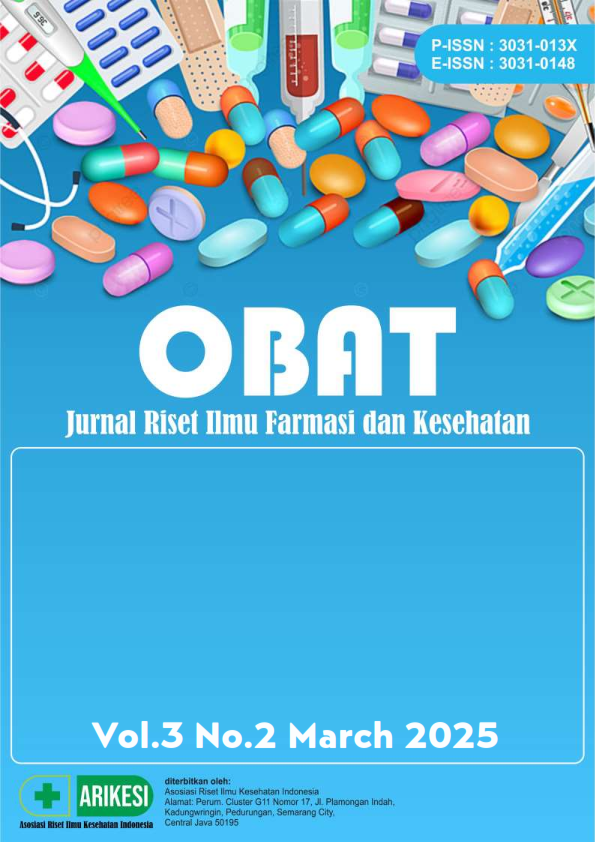The Role of CRISPR-Cas9 in Gene Editing
DOI:
https://doi.org/10.61132/obat.v3i2.1108Keywords:
CRISPER Cas9, Gene Editing, Human germline, EthicsAbstract
The CRISPR-Cas9 technique is a contemporary technology that has transformed the process of genetic modification, allowing scientists to target genomes in living organisms with precision and simplicity. Numerous practical applications of significant importance, including the introduction of new genes into living cells, are facilitated by the CRISPR-Cas9 system's advanced level of gene targeting, precision, and simplicity of use. An enigmatic process involving repeated DNA sequences in E. coli initiated the emergence of this CRISPR-Cas9 mechanism. After observing this phenomenon in bacteria, scientists initiated an investigation into its function. It was noted that E. coli employs it as a self-defence mechanism against bacteriophage attacks and plasmids. CRISPR-Cas9, a novel method for genetic modification, was created as a result of this investigation. This system has been re-engineered by scientists to be more broadly applicable, allowing for the modification of the genetic code of virtually any organism, surpassing the scope of self-defence. The CRISPR-Cas9 system-based gene editing mechanisms have the potential to produce substantial results that were previously difficult to achieve. Nevertheless, the question of genetic modification through the application of this technology prompts debates and demands for the resolution of the ethical, social, and legal issues that are associated with its application. The potential applications of the CRISPR-Cas9 system are seemingly boundless.
Downloads
References
Abdallah, N. A., Elsharawy, H., Abulela, H. A., Thilmony, R., Abdelhadi, A. A., & Elarabi, N. I. (2025). Multiplex CRISPR/Cas9-mediated genome editing to address drought tolerance in wheat. GM Crops & Food, 16(1), 1–17.
Begagić, E., Bečulić, H., Đuzić, N., Džidić-Krivić, A., Pugonja, R., Muharemović, A., Jaganjac, B., Salković, N., Sefo, H., & Pojskić, M. (2024). CRISPR/Cas9-mediated gene therapy for glioblastoma: A scoping review. Biomedicines, 12(1), 238.
Cho, S. W., Kim, S., Kim, Y., Kweon, J., Kim, H. S., Bae, S., & Kim, J.-S. (2014). Analysis of off-target effects of CRISPR/Cas-derived RNA-guided endonucleases and nickases. Genome Research, 24(1), 132–141.
Cong, L., Ran, F. A., Cox, D., Lin, S., Barretto, R., Habib, N., Hsu, P. D., Wu, X., Jiang, W., & Marraffini, L. A. (2013). Multiplex genome engineering using CRISPR/Cas systems. Science, 339(6121), 819–823.
Di Cristina, G., Dirksen, E., Altenhein, B., Büschges, A., & Korsching, S. I. (2025). Pioneering genome editing in parthenogenetic stick insects: CRISPR/Cas9-mediated gene knockout in Medauroidea extradentata. Scientific Reports, 15(1), 2584.
Fu, Y., Foden, J. A., Khayter, C., Maeder, M. L., Reyon, D., Joung, J. K., & Sander, J. D. (2013). High-frequency off-target mutagenesis induced by CRISPR-Cas nucleases in human cells. Nature Biotechnology, 31(9), 822–826.
Gallo, M. E., Cowan, T., Sarata, A. K., & Sargent, J. F. (2017). Advanced gene editing: CRISPR-Cas9. Congressional Research Service.
Guan, L., Han, Y., Zhu, S., & Lin, J. (2016). Application of CRISPR-Cas system in gene therapy: Pre-clinical progress in animal model. DNA Repair, 46, 1–8.
Hendel, A., Fine, E. J., Bao, G., & Porteus, M. H. (2015). Quantifying on- and off-target genome editing. Trends in Biotechnology, 33(2), 132–140.
Hsu, P. D., Scott, D. A., Weinstein, J. A., Ran, F. A., Konermann, S., Agarwala, V., Li, Y., Fine, E. J., Wu, X., & Shalem, O. (2013). DNA targeting specificity of RNA-guided Cas9 nucleases. Nature Biotechnology, 31(9), 827–832.
Irfan, M., Majeed, H., Iftikhar, T., & Ravi, P. K. (2024). A review on molecular scissoring with CRISPR/Cas9 genome editing technology. Toxicology Research, 13(4), tfae105.
Kim, D., Bae, S., Park, J., Kim, E., Kim, S., Yu, H. R., Hwang, J., Kim, J.-I., & Kim, J.-S. (2015). Digenome-seq: Genome-wide profiling of CRISPR-Cas9 off-target effects in human cells. Nature Methods, 12(3), 237–243.
Liang, P., Xu, Y., Zhang, X., Ding, C., Huang, R., Zhang, Z., Lv, J., Xie, X., Chen, Y., & Li, Y. (2015). CRISPR/Cas9-mediated gene editing in human tripronuclear zygotes. Protein & Cell, 6(5), 363–372.
Ma, Y., Zhang, L., & Huang, X. (2014). Genome modification by CRISPR/Cas9. The FEBS Journal, 281(23), 5186–5193.
Wang, S.-W., Gao, C., Zheng, Y.-M., Yi, L., Lu, J.-C., Huang, X.-Y., Cai, J.-B., Zhang, P.-F., Cui, Y.-H., & Ke, A.-W. (2022). Current applications and future perspective of CRISPR/Cas9 gene editing in cancer. Molecular Cancer, 21(1), 57.
Yang, H., Wang, H., Shivalila, C. S., Cheng, A. W., Shi, L., & Jaenisch, R. (2013). One-step generation of mice carrying reporter and conditional alleles by CRISPR/Cas-mediated genome engineering. Cell, 154(6), 1370–1379.
Zaman, Q. U., Wen, C., Yuqin, S., Mengyu, H., Desheng, M., Jacqueline, B., Baohong, Z., Chao, L., & Qiong, H. (2021). Characterization of SHATTERPROOF homoeologs and CRISPR-Cas9-mediated genome editing enhances pod-shattering resistance in Brassica napus L. The CRISPR Journal, 4(3), 360–370.
Zhang, H., Qin, C., An, C., Zheng, X., Wen, S., Chen, W., Liu, X., Lv, Z., Yang, P., & Xu, W. (2021). Application of the CRISPR/Cas9-based gene editing technique in basic research, diagnosis, and therapy of cancer. Molecular Cancer, 20, 1–22.
Zhang, H., T. (2014). CRISPR-Cas9: Engineering a revolution in gene editing. Nature, 522(7554).
Zhang, X.-H., Tee, L. Y., Wang, X.-G., Huang, Q.-S., & Yang, S.-H. (2015). Off-target effects in CRISPR/Cas9-mediated genome engineering. Molecular Therapy-Nucleic Acids, 4,
Downloads
Published
How to Cite
Issue
Section
License
Copyright (c) 2025 OBAT: Jurnal Riset Ilmu Farmasi dan Kesehatan

This work is licensed under a Creative Commons Attribution-ShareAlike 4.0 International License.





